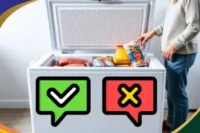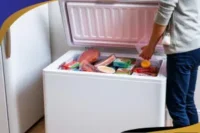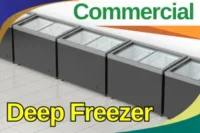Refrigerator Not Cooling but Light On? Easy Steps to Fix It
Published: 26 Oct 2025
Asma came home with bags full of groceries and neatly placed them in her fridge. By the next morning, she was shocked to find that, although the light was working, her milk had spoiled, and the vegetables had wilted. This is a real-life example of a fridge not cooling, but the light is on, a problem that can leave anyone frustrated.
Don’t worry—we have prepared a complete guide for you in which you will find the solution to every kind of problem. Without wasting time, let’s move on to our topic.
Are you ready? Let’s start.
How a Fridge Works in Simple Words
A fridge may look simple, but it has many parts working together to keep your food cold. The light only shows that the power is on, but cooling depends on other components.
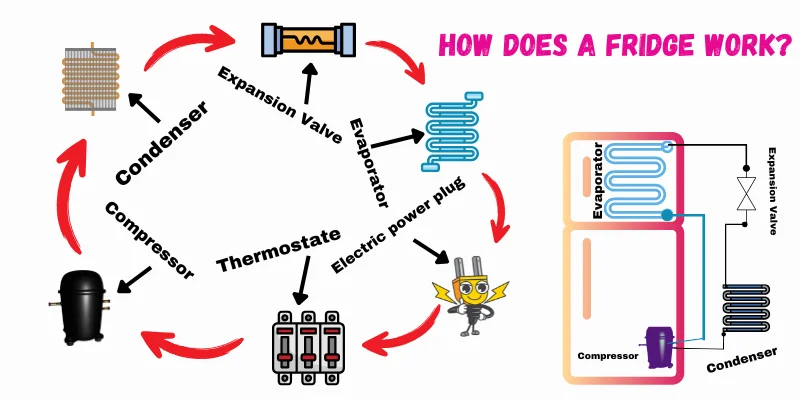
- Power supply → runs the light and starts the cooling system.
- Compressor → the “heart” of the fridge, pumps refrigerant gas.
- Condenser coils → release heat outside the fridge.
- Evaporator coils → create cold air inside the fridge.
- Fans → move the air so cooling spreads evenly.
- Thermostat or control board → tells the system when to start and stop cooling.
👉 We have already written a detailed article on how a refrigerator works. You can check it here to learn the steps in detail.
Quick Checks Before You Panic
Sometimes the problem is small, and you can fix it in minutes. Before you call a repairman, try these quick checks first:
- Check the power
- Check the temperature knob
- Check the location
- Check the leveling
- Check the door seals.
👉 Many times, just fixing one of these small things makes the refrigerator work again. For example, one family found their fridge wasn’t cooling simply because it was pushed too close to the wall. After moving it a few inches forward, it worked perfectly.
Common Causes of a Fridge Not Cooling but the Light Is On
When the refrigerator light works but cooling stops, it usually means one of the key parts is not doing its job. This problem can come from simple issues like dust or blocked vents, or from bigger faults like a broken compressor.
Here are the most common causes:
- Dirty condenser coils
- Evaporator fan issues
- Condenser fan not spinning
- Thermostat or temperature control problems
- Blocked air vents or a damper
- Door gasket leaks
- Frost build-up or defrost failure
- Compressor or start relay problem
- Refrigerant leak or low gas
- Control board or defrost timer failure
Let’s discuss each point in detail.
Dirty Condenser Coils
Condenser coils are found at the back or bottom of the fridge. Their job is to release heat. When these coils are covered in dust and dirt, the fridge struggles to cool properly. Cleaning them with a coil brush or a vacuum can often bring the cooling back to normal.
Evaporator Fan Issues
Inside the freezer, the evaporator fan spreads cold air into the fridge section. If this fan is broken, cold air cannot move around. You may notice the freezer is cold, but the fridge part is still warm, or you may hear strange noises from inside.
Condenser Fan Not Spinning
The condenser fan is placed near the compressor at the back. It keeps the compressor cool while it runs. If the fan does not spin, the back of the fridge will feel very hot, and the cooling inside will become weak.
Thermostat or Temperature Control Problems
The thermostat works like a remote control for your refrigerator’s cooling. It tells the compressor when to start and stop. If it fails, the fridge will not cool even though the light is working.
Blocked Air Vents or Damper
Air moves inside the fridge through small vents. If food boxes or containers block these vents, the cold air cannot flow properly. This makes some areas warm while others stay cold.
Door Gasket Leaks
The rubber gasket around the refrigerator door keeps the cold air inside. If it is loose, cracked, or dirty, cold air escapes every time the door is closed. This forces the fridge to run harder and still not cool well.
Frost Build-Up or Defrost Failure
When ice collects on the evaporator coils inside the freezer, it blocks airflow. This usually happens if the defrost system fails. The fridge then runs but does not cool properly until the ice is removed.
Compressor or Start Relay Problem
The compressor is the “heart” of the cooling system. If the start relay fails or the compressor itself is damaged, the fridge may click on and off without cooling. This is a serious problem that often needs professional help.
Refrigerant Leak or Low Gas
Refrigerant gas is what makes cooling possible. If there is a leak, the fridge cannot produce cold air even if all other parts are working. Only a trained technician can check and refill the gas safely.
Control Board or Defrost Timer Failure
The control board is like the “brain” of the fridge. It sends signals to the fans, compressor, and defrost system. If it fails, the fridge may stop cooling even though the light works.
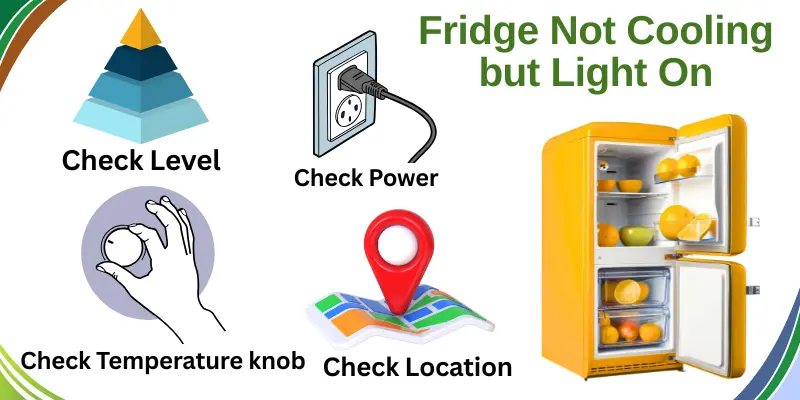
👉 These are the main reasons why your fridge light is on but cooling has stopped. In the next section, we will cover a step-by-step troubleshooting guide so you can test and fix some of these problems at home.
Step-by-Step Troubleshooting Guide (DIY Friendly)
If your fridge light works but it is not cooling, try these simple steps before calling a technician. Many times, a small check can fix the problem.
- Check Power and Settings
Make sure the plug is connected properly and the breaker is not tripped. Also, look at the temperature knob—it should be set in the middle, not too high or too low. - Move and Level the Fridge
Fridges need space to breathe. Move it a few inches away from the wall and check if it is standing straight. A tilted fridge can affect cooling. - Clean the Condenser Coils
Dirty coils stop the fridge from releasing heat. A quick cleaning with a soft brush or a vacuum often improves cooling right away. - Listen for Fans and Compressor
Stand near the fridge and listen carefully. You should hear the fans and a gentle humming from the compressor. If you hear clicks but no hum, there may be a bigger issue. - Clear Vents and Check Gaskets
Look inside the fridge to make sure no food items are blocking the air vents. Also, test the rubber door gasket with the paper test—if the paper slips out, the gasket needs fixing. - Defrost Heavy Ice
If you see a thick layer of ice in the freezer, it can block airflow. Switch off the fridge and let it defrost fully before turning it back on. - Unplug for 5 Minutes to Reset
Sometimes the control board needs a reset. Unplug the fridge for five minutes and then plug it back in. This can fix small electronic glitches. - Still Warm? Call a Technician
If the fridge is still not cooling after all these steps, it’s time to call a professional. Problems like gas leaks, compressor faults, or control board issues need expert repair.
👉 By following these steps, you can fix many common cooling problems at home without spending extra money.
Maintenance Tips to Keep Your Fridge Cooling Properly
Follow these simple habits to avoid common cooling problems and save on repair bills:
- Clean condenser coils every 6 months → Dusty coils reduce cooling efficiency. Use a brush or vacuum to clean them.
- Keep at least 2–3 inches from the wall → Fridges need space to release heat. Ensure enough space behind and on the sides for proper airflow.
- Do not overload shelves; cold air must circulate. Leave gaps between containers and avoid blocking vents.
- Check door gaskets yearly → Test with a piece of paper. Replace if it slips out easily or is cracked.
- Defrost when frost builds up → Thick ice blocks airflow. Switch off the fridge and let it fully defrost if needed.
👉 By doing these easy steps, your fridge will work better, use less power, and stay in good condition for a long time.
Read more in our guide on refrigerator maintenance tips.
Real-Life Examples and Stories
Sometimes, the best way to understand fridge problems is through real stories. Here are a few examples of how simple fixes saved the day:
- The Dusty Coils Problem → One user found their condenser coils covered in dust. A quick cleaning brought the cooling back within hours.
- The Sunlight Issue → A family kept their fridge near a sunny window. Moving it to a shaded corner fixed the cooling problem.
- The Blocked Vent Trouble → Another user stacked containers against the fridge vents. After rearranging the shelves, the cooling returned to normal.
- The Reset Trick → In one case, a fridge stopped cooling but started again after the owner unplugged it for five minutes.
👉 These simple stories show that not every fridge problem means an expensive repair. Sometimes, a small step is all it takes to solve the issue.
Conclusion
So guys, in this article, we’ve covered fridge not cooling, but the light is on in detail. My personal recommendation is to always start with the simple checks first, like coils, vents, and gaskets, before calling a technician. It saves time and money.
If you found this guide helpful, share it with others who may be facing the same problem, and explore our other Types of inverter refrigerator.
Frequently Asked Questions (FAQs)
When your fridge light is working but it is not cooling, many small questions can come to mind. To make things easier, we’ve listed some of the most common ones here. These quick FAQs will help you understand extra points that were not explained in detail above.
- Why does my fridge light work, but it’s not cooling?
- How long should I wait for my fridge to cool after fixing a problem?
- Can a power outage cause my fridge to stop cooling?
- Is it safe to keep food in a fridge that isn’t cooling?
- How do I know if my compressor is running or not?
- What does it mean if my fridge makes a clicking sound but doesn’t cool?
- Can low refrigerant gas cause the light to stay on but no cooling?
- Should I repair my old fridge or buy a new one if the cooling fails?
- How much does it usually cost to fix a fridge that is not cooling?
- When should I call a professional instead of trying DIY fixes?
Now we will discuss in detail the answers to all the questions one by one.
If the fridge light is on, it means the power supply is fine. The real issue is usually with cooling parts like the compressor, fans, thermostat, or coils. When one of these stops working, the fridge cannot make cold air even though the light works. Sometimes it’s a small fix like blocked vents, but other times it needs professional repair.
After you clean coils, adjust settings, or reset the fridge, it usually takes 3–6 hours to feel cold again. Some fridges may take up to 24 hours to fully stabilize the temperature. Avoid opening the door too often during this time, as it lets cold air escape. Patience is important because cooling is a slow process.
Yes, a power outage can sometimes cause the control board or thermostat to reset in the wrong way. Even though the light comes back on, the cooling cycle may not restart properly. In such cases, unplugging the fridge for five minutes and plugging it back in often helps. If it still doesn’t cool, another part may have failed during the outage.
No, food can spoil quickly if the fridge isn’t cold. Dairy products, meat, and cooked food can go bad within 2–4 hours. Eating spoiled food can cause health problems, so it’s safer to move food into a cooler with ice packs. Always check for unusual smell or texture before eating.
The compressor usually makes a gentle humming or buzzing sound when it’s working. If you don’t hear it at all, touch the back of the fridge—if it’s not warm, the compressor may not be running. Clicking sounds without cooling can also be a sign of compressor or relay failure. If unsure, it’s best to have a technician test it.
A clicking sound usually comes from the compressor trying to start but failing. This often points to a faulty start relay, capacitor, or a failing compressor itself. The fridge may try to restart every few minutes, but it never actually runs. This is not something you can usually fix at home and requires professional attention.
Yes, if the gas is low, the fridge cannot produce cold air even though the power and light work. Refrigerant is the fluid that moves through coils to create cooling. Without enough of it, the system keeps running, but the inside stays warm. Only a licensed technician can check and refill refrigerant safely.
It depends on the age and cost of repair. If your fridge is less than 8–10 years old, repairs are usually worth it. But if it’s older, uses too much energy, or needs expensive fixes like a compressor replacement, buying a new fridge may be smarter. Always compare repair costs with the price of a new appliance before deciding.
The cost depends on the problem. Simple fixes like cleaning coils or replacing a thermostat can be under $100. Bigger repairs, such as compressor replacement or refrigerant refill, can range from $200–$600 or more. That’s why it’s important to test simple things first before calling for repairs.
If you’ve checked power, settings, coils, fans, vents, and seals but the fridge still won’t cool, it’s time to call a pro. Also, any issue involving the refrigerant, compressor, or control board should not be handled at home. Professionals have the right tools and training to handle these safely. Calling early can also prevent further damage to your fridge.


